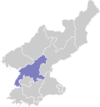Anju, South Pyongan

Climate
| Climate data for Anju, South Pyongan (1991–2020) | |||||||||||||
|---|---|---|---|---|---|---|---|---|---|---|---|---|---|
| Month | Jan | Feb | Mar | Apr | May | Jun | Jul | Aug | Sep | Oct | Nov | Dec | Year |
| Mean daily maximum °C (°F) | −1.1 (30.0) |
2.4 (36.3) |
8.8 (47.8) |
16.4 (61.5) |
22.2 (72.0) |
26.3 (79.3) |
28.3 (82.9) |
29.1 (84.4) |
25.4 (77.7) |
18.5 (65.3) |
9.0 (48.2) |
0.5 (32.9) |
15.5 (59.9) |
| Daily mean °C (°F) | −6.5 (20.3) |
−2.9 (26.8) |
3.2 (37.8) |
10.3 (50.5) |
16.3 (61.3) |
21.1 (70.0) |
24.2 (75.6) |
24.5 (76.1) |
19.4 (66.9) |
12.1 (53.8) |
3.9 (39.0) |
−4.1 (24.6) |
10.1 (50.2) |
| Mean daily minimum °C (°F) | −11.5 (11.3) |
−7.7 (18.1) |
−1.5 (29.3) |
4.6 (40.3) |
10.8 (51.4) |
16.5 (61.7) |
20.7 (69.3) |
20.7 (69.3) |
14.5 (58.1) |
6.6 (43.9) |
−0.6 (30.9) |
−8.2 (17.2) |
5.4 (41.7) |
| Average precipitation mm (inches) | 7.8 (0.31) |
15.2 (0.60) |
20.9 (0.82) |
48.8 (1.92) |
78.8 (3.10) |
97.8 (3.85) |
292.8 (11.53) |
243.8 (9.60) |
100.3 (3.95) |
50.1 (1.97) |
46.0 (1.81) |
15.4 (0.61) |
1,017.7 (40.07) |
| Average precipitation days (≥ 0.1 mm) | 2.9 | 3.2 | 3.7 | 5.7 | 7.5 | 8.0 | 12.0 | 10.0 | 6.0 | 5.5 | 6.4 | 5.1 | 76.0 |
| Average snowy days | 3.9 | 2.7 | 1.6 | 0.1 | 0.0 | 0.0 | 0.0 | 0.0 | 0.0 | 0.1 | 1.3 | 4.7 | 14.4 |
| Average relative humidity (%) | 70.8 | 67.7 | 67.3 | 66.1 | 70.8 | 76.4 | 82.8 | 82.0 | 76.2 | 72.4 | 72.4 | 71.2 | 73.0 |
| Source: Korea Meteorological Administration | |||||||||||||
Administrative divisions
Anju-si is divided into 20 tong (neighbourhoods) and 22 ri (villages):
|
|
Economy
Anju lies near large deposits of anthracite coal, and contains one of the largest coal production facilities in the country. The deposits contain more than 130 million metric tons of coal. Namhŭng-dong is the location of the Namhŭng Youth Chemical Complex, one of North Korea's most important chemical combines. Anju also contains at least one hotel open for foreigners, used primarily to accommodate for more travelers during peak holiday times.
Anju is the location of the Cemetery for Martyrs of the Chinese People's Volunteers, commemorating Korean War dead.
Transportation
Anju-si is served by several stations on the P'yŏngŭi and Kaech'ŏn lines of the Korean State Railway.
Anju has a trolleybus system with one line to Sinanju Chongnyon station. It formerly had another line to Namhung Youth Chemical Complex that looped around the entire complex which closed around 2000.
See also
References
- ^ North Korean Central Statistic Bureau, 2008 Census Archived 2010-03-31 at the Wayback Machine.
- ^ "30 years report of Meteorological Observations in North Korea (1991 ~ 2020)" (PDF) (in Korean). Korea Meteorological Administration. pp. 214, 306, and 344. Archived (PDF) from the original on 29 January 2022. Retrieved 24 March 2022.
- ^ North Korea Handbook. M.E. Sharpe. 2003. ISBN 0765610043. Retrieved 2012-07-18.
- ^ Kuo, Chin S. (1994). "The mineral industry of North Korea" (PDF). Retrieved 2012-07-18.
- ^ Joseph S. Bermudez Jr. (10 April 2014). "North Korea's Namhung Youth Chemical Complex: Seven Years of Construction Pays Off". US-Korea Institute at SAIS.
- ^ Gareth Johnson (20 December 2019). "Anju County, North Korea". Young Pioneer Tours.
- ^ "Anju". transphoto.org. Retrieved 2021-01-02.
Further reading
- Dormels, Rainer. North Korea's Cities: Industrial facilities, internal structures and typification. Jimoondang, 2014. ISBN 978-89-6297-167-5
External links
- City profile of Anju Archived 2016-03-09 at the Wayback Machine
